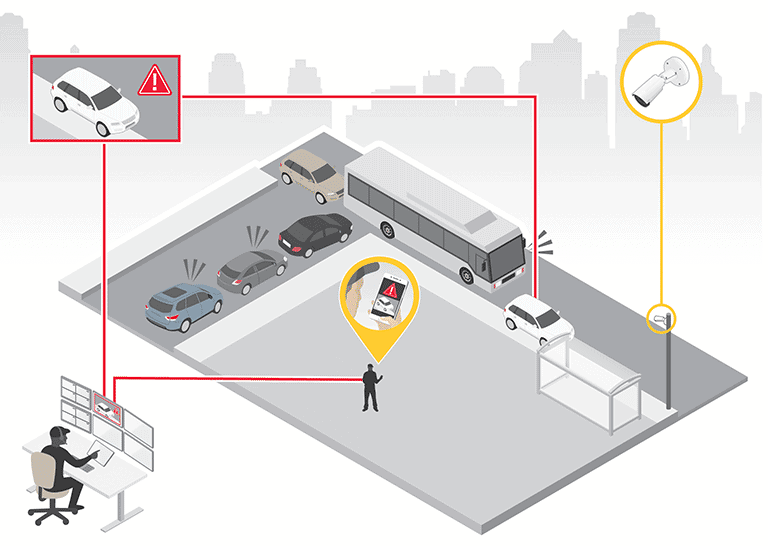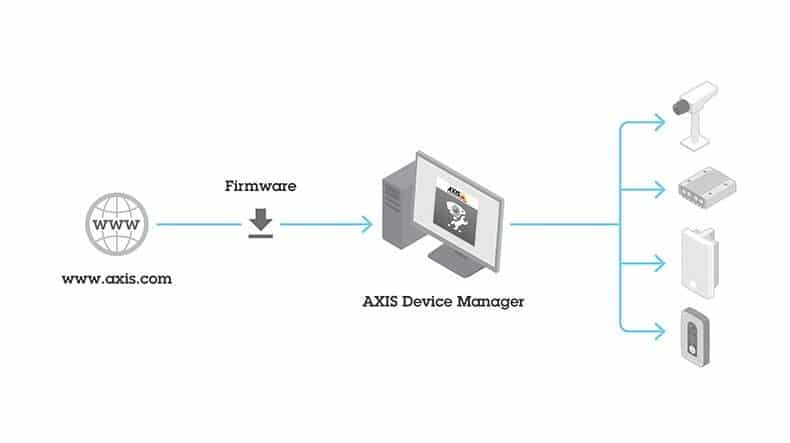Axis’ transition phase seems to be in its final stage. It was once a real IT company, then profiled itself more as a specialist in security cameras and now the company is heading back towards its roots as an IT company. Developments at the company follow each other rapidly, but the most important thing is that the focus has shifted from products to solutions.
The company is known by many people for its security cameras. At the end of 2018 we already talked to Axis about the developments within the company, at that time we came to the conclusion that the company is slowly transforming from camera to IT company. Recently we spoke again with Axis, with business development manager Middle Europe Edwin Beerentemfel to be precise. We can now say that Axis looks more like an IT company again. The transition itself will never be complete, because a company is always transforming. Certainly a company of this size.
Focus on solutions and innovation
We recently participated in the virtual conference Axis Inspire 2020, where the company presented new products and one of the founders told his story. Martin Gren gave his vision on the company, the future and even gave a glimpse into the roadmap. An interesting story of a man who once developed the first camera with a network port.
Although Axis is changing more and more towards an IT company, it will of course always remain a security camera company. All products developed by the company are generally based on camera technology or other sensors that somehow contribute to a detection platform. With a detection platform, we mean a system of which the camera is a part off. This could be a network of security cameras with, for example, radar detection, license plate registration or perhaps even an audio system. It can also be a smart city solution, in which the system is much broader and in addition to video also sound detection is used. The biggest change at Axis is that they have been thinking bigger in recent years.
Thinking bigger and more in solutions
The focus is no longer on improving the security camera. Because there’s not much more to gain from that. The company looks more at the bigger picture. What kind of problems do the customers have and how can we solve them with the help of camera technology? This results in products such as license plate registration, the detection of faulty parked cars on the street or on our own premises, or the automatic counting of huge crowds on city squares. Camera technology is the basis for this. In this case, camera technology is combined with software developed by Axis that can perform these tasks using a camera.

New technologies like machine learning and artificial intelligence (AI) allow Axis to build better solutions with its cameras. There has been considerable investment in this in the recent period and this is now beginning to bear fruit.
By using machine learning and AI, it is possible to train models that can recognise badly parked cars or license plates in video footage. This used to be much more difficult to do. In addition, these new technologies enable Axis to combine cameras. For example, cameras are being developed with multiple sensors, allowing a 360-degree view to be recorded. This requires multiple sensors that are stitched together with software. You can use and store one stream for 360 degree video monitoring. Previously, this required multiple cameras, angles and streams.
Axis now also active in the market of Bodycams
Since a couple of months, Axis is also active in the market for bodycams. A market that has already knocked on Axis’ door a few times, but the company did not dare to enter this market segment before. The technology and opportunities in this market were not yet mature enough for Axis to invest in. That has changed in recent years and now Axis does dare to take the step and enter this market. A lot has changed in recent years if we look at sensors and energy-efficient chips since the introduction of the smartphone. This kind of technology can be combined with Axis’ experience in video surveillance and the robustness in which it develops its normal cameras.
Axis has now developed a bodyworn camera that also brings innovation to this market. These cameras are not part of the existing Axis platform, because instead of the ARTPEC chips from Axis, more energy-efficient models from a third party are used. The bodyworn cameras are part of a fully closed platform. Third parties cannot develop apps for it. The customer has to make do with the standard Axis offer. We asked Beerentemfel why this model was chosen because it is usually a USP of Axis that third-party applications can be added to their camera’s.
“We’re dealing with a moving sensor and battery life, as well as potential camera theft. That calls for different choices.”
Beerentemfel told Techzine: “Of course we would have liked to offer all the options that we normally offer on our normal security cameras, but this is a completely different product with different requirements. You have to deal with a moving sensor and battery life, but also with potential theft of the camera. That calls for different choices.”
The portable bodycams are really a different kind of video product than a security camera. According to Beerentemfel, an important difference, for example, is that a security camera is at a fixed point. A bodycam is constantly in motion, that has to be taken into account. In the end, you do want stable video footage. Another important requirement is battery life, one must be able to work all day without recharging the camera. The bodycam of Axis works 12 hours at a Full HD resolution and 17 hours at a 720p resolution. The images are currently stored by default on a memory card. These recordings must be encrypted, so that in the event of theft or loss, the footage cannot be viewed by an external party. For this reason, it was decided to keep the platform closed and to apply encryption.
The intention is that the recordings will soon be able to be streamed to the control room if a wifi network is present. Axis will make this possible by through a software update. There is not yet a 4G or 5G version of the bodycam, but this will undoubtedly follow in the future. This will require new hardware. In terms of integration, the possibilities are still limited. However, Axis is looking at possible Bluetooth integrations with the equipment of the employee. In the case of a police officer, for example, a signal could be sent when he grabs his batton or pistol. The camera can be switched on automatically or the control room knows immediately that the police officer is in a threatening situation.
In the future, it may also be possible to use 4G or 5G for real-time video analysis from the control room. It is still too early at the moment. Axis does, however, see sufficient opportunities for further development of this product. There is also a great demand for this type of solution from public transport and airports.
Axis will replace closed software platform with containers and open standard
One of Axis’ unique selling points is the software platform for its regular security cameras. Axis has had this platform for many years, and many partners use it. Third parties can develop applications for these camera’s and some other sensors as well. However, it is also a proprietary platform. The apps only work with Axis products. Axis would like to change this. The co-founder of Axis, Martin Gren, said that it should become an open container platform. It is a lot safer to start with because the containers are executed as an isolated application that can only communicate with the Axis platform through APIs. Beerentemfel was able to add that Axis also strives for an open standard, so that applications will soon be interchangeable with other platforms. This offers partners the advantage that their applications can be used more widely and for Axis the advantage is that many more applications will become available.
Axis is currently still busy developing the new platform, which should become available somewhere in the coming years. It is also still looking for the best open standard, and with which companies it will work together. There are some initiatives, but there is not yet a consortium with a truly open and vendor independent platform.
This strategy shows that Axis is once again really thinking as an IT company and is committed to innovation. In the long term, Axis will certainly benefit from this.
Simplify camera management through the cloud
Axis Device Manager will also get a major upgrade in the coming year, with the new Axis Device Manager Extend. With the normal device manager, you can find cameras on the network, configure them or push a configuration to the camera. It also includes a piece of firmware and license management. With the new Axis Device Manager Extend, Axis takes a lot of manual work out of your hands.

Extend will be more policy-based. As an administrator, you set a policy which configuration you want to run on the camera, which firmware needs to be used, which security settings, which applications and so on. The policies are rolled out automatically. It can also be done manually, but that is not recommended. Every camera on the network gets these policies pushed and has to abide by them. If a setting is changed on the camera itself, the device manager will automatically change it back to the policy setting. So that as an administrator, you will no longer have to deal with different configurations and firmware versions. It will make the administrators live a lot easier.

In a network, there should always be an Axis site controller, which communicates with all the cameras and other Axis devices. The site-controller also communicates with the Axis Cloud. From the cloud, the administrator has an overview of all devices and hardware diagnostics. By sharing the log information of the cameras with the Axis Cloud, Axis can detect problems at an early stage and inform the administrator. The Axis Cloud is mainly an informative portal, the real actions are done on the site controller. All credentials are stored there, which are not shared with the Axis Cloud.
Axis still cautious with cloud management
Following our conversation with Beerentemfel, we conclude that Axis is still cautious about cloud solutions. This cautiousness has to do with the Axis partner model, where there are still many conservative partners who prefer on-premises management and manual configurations. Ultimately, in our view, this is a dead-end. In the coming years, Axis will have to move more to the cloud to enable innovation and to relieve the burden on partners and administrators. Innovation cannot be slowed down in that respect. Also, maintaining proper compliance is possible in the cloud, something their traditional partners fear.
Axis really thinks like an IT company again in the search for innovative solutions. Then you simply cannot ignore the flexibility, scalability and innovation speed of the cloud. Partners will, in the end, have to embrace the cloud, they cannot escape from this. Especially with the introduction of 5G, the demand for machine learning and AI will increase. Sometimes this can be done on the device itself, but it will also happen on a central location. The most logical location is from the cloud. We will continue to follow Axis closely.
Tip: A city only really gets smart by breaking through data silos
